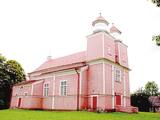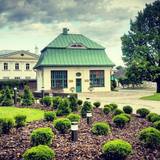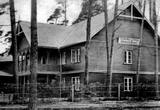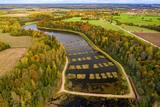| Nr | Nosaukums | Apraksts |
|---|---|---|
|
Lauku sētā, kas atrodas Daugavas krastā, audzē dažādas ogas, ābolus un bumbierus. Viesi var iet dārzā, cienāties un iegādāties izaudzēto produkciju. |
||
|
Ceļojums gardēžiem un ceļotgribētājiem, kurās būs iespēja nogaršot ne tikai tradicionālos Kurzemes ēdienus, kā sklandraušus un žāvētas zivtiņas, bet arī pankūkas no svaigi maltiem miltiem, zemnieku gatavotos sierus, mājas vīnus un citas lauku veltes. Līdz ar lauku labumu degustācijām varē izstaigāties dabas takas un iepazīt kultūrvēsturisko mantojumu. Maršruta informācija no Latvijas Lauku foruma |
||
|
Atrodas mežā, netālu no Kaltenes. Labiekārtota (laipas, kāpnes, informācijas stendi) taka, kas iepazīstina ar Latvijai samērā neparastu dabas pieminekli (aizsargājams) – Kaltenes kalvām, kas ir lieli, līdztekus Rīgas jūras līča krasta līnijai orientēti laukakmeņu krāvumi. Uzskata, ka tos veidojuši Baltijas ledus ezera ūdeņi un ledi. Garums – ap 1,5 km. |
||
|
Kafejnīca "Ieviņa" atrodas Tukuma vēsturiskajā centrā. Piedāvā latviskus gardumus – bulciņas, plātsmaizes un pīrāgus. |
||
|
Kafejnīca "Dzirnas" atrodas Gaigalavas centrā – bijušajā kolhoza administratīvā centra ēkā. Ēdiena gatavošanā izmanto produktus no savas un citām lauku saimniecībām. Latviešu virtuve: Pupu zupa ar grūbām, skābu kāpostu zupa, zirņu zupa, galda biešu lapu zupa, skābeņu zupa, zivju zupa no līņa vai karpas, ceptas ribiņas, cepetis, viltotais zaķis, krāsnī cepta karpa, kaltētas zivis, biezpiena krēms ar ķīseli, cepti āboli ar vaniļas mērci, pītās ruletes, žāvēti augļi un cidoniju sukādes. Īpašais ēdiens: Pupu pankūkas. |
||
|
Atrodas Feimaņu dienviddaļā. Dievnams celts laikā no 1756. – 1760. gadam. Feimaņi bija muižnieku Korfu dzimtas īpašums. Baznīca mainīja savu konfesiju atbilstoši Korfu ticības maiņai, pārejot no luterāņu uz katoļu konfesiju. Vērts pieminēt, ka Feimaņu katoļu baznīca starp dievnamiem Rēzeknes novadā izceļas ar vislielāko valsts nozīmes mākslas pieminekļu daudzumu. Starp tiem jāmin biktssols, baznīcēnu soli, ērģeļu prospekts, sudraba kausi un piecpadsmit triju altāru kokgriezumi no 18.gs. Pie baznīcas ieejas vārtiem slejas zvanu tornis ar četriem zvaniem. Klusajā nedēļā zvanu vietā baznīcā lieto t.s. „klabatas”, kas ir ap 2 m gari un 1 m augsti priekšmeti, kas atgādina senlaicīgus veļas ruļļus. Feimaņos atrodas viena no Latvijas trim karogu darbnīcām, kurā darbojas Baltijā modernākās iekārtas. Šajā vietā gan idejiski, gan fiziski „dzima” Latgales karogs. |
||
|
Kretoņu (Kretuonas) ezera dienvidu krastā (ezeru gan neredz aizauguma dēļ) meklējams Kretoņu ciems. Šķiet, ka šī vieta ir „aizķērusies" pagātnē. Cauri ciemam iet viena iela, kurai abās pusēs izvietojušās 19. – 20. gs. mijā (dažas pat mazliet agrāk – 19. gs. vidū) celtās saimniecības. Te redzamas gan dzīvojamās, gan saimniecības ēkas, kuras rada etnogrāfiska brīvdabas muzeja sajūtu. Dažas no tām gan ir „padevušās" laika zobam. Lai vai kā, šis ir viens no neparastākajiem nacionālā parka etnogrāfiskajiem ciemiem, kuru pa „galveno ielu" vērts izstaigāt visā garumā. Šim, tāpat kā pārējiem etnogrāfiskajiem ciemiem ir piešķirts kultūras mantojuma objekta statuss. |
||
|
Atrodas Alūksnes pilsētas centrā, Pils ielā 25A. Bībeles muzejs ir vienīgais Latvijā un Baltijā, kas savā krājumā glabā 1694. gadā latviešu valodā tulkotās Bībeles pirmizdevumu. Alūksnē varat ielūkoties latviešu valodas un kultūras vēsturē. Bībeles muzejs piedāvā iepazīties ar “Bībeles ceļu” no pašas pirmās, E. Glika Alūksnē tulkotās Bībeles, līdz mūsdienu izdevumiem. Ekspozīcijā aplūkojamas Bībeles 40 pasaules valodās, dažādi sprediķu un dziesmu grāmatu izdevumi. Iespēja palasīt tekstus vecajā rakstībā un izjust valodas attīstību gadsimtu gaitā. |
||
|
Divas mazas apdzīvotas vietas nacionālā parka dienvidrietumu daļā. No kādreiz piecām Kolski ciema saimniecībām līdz mūsdienām ir saglabājusies tikai viena. Kolski iedzīvotājus līdzīgi kā citviet Baltijas valstīs pēc 2. pasaules kara deportēja uz Sibīriju. Kolski apkārtnē redzamie mājdzīvnieki „apsaimnieko” šejienes pļavas, neļaujot tām aizaugt ar mežu. Tādējādi tiek uzturēta apkaimes vēsturiskā ainava. 3 km dienvidrietumos meklējams Kobasāres ciems. Tā nosaukums (koopa no igauņu valodas nozīmē ala, saar – sala) atgādina par Ziemeļu kara notikumiem, kura laikā cilvēki slēpušies pašu raktās alās. Kobasārē un tam blakus esošajā Apjas (Apja) ciemā var izbaudīt patiesi 21. gadsimtam nepierastas lauku ainavas. |
||
|
„Strand” komplekss bija lielākais un greznākais Neibādē. Tas sastāvēja no trim ēkām, deju paviljona un parka. Mūsdienās saglabājusies tikai viesnīcas ēka, kurā bija iekārtota Saulkrastu ambulance – Ainažu ielā Nr. 17. (Avots: Saulkrastu TIC) |
||
|
„Jokas” atrodas 4 km austrumos no Turlavas. Saimnieks Jānis Uzulēns uzņēmumu mērķtiecīgi attīstījis un paplašinājis kopš tās dibināšanas 2011. gadā. Saimniecības lepnums ir gaļas lopu ganāmpulks, kurā ir ap 70 govju, kā arī pieci zirgi. Saimniecībā ražo desas un citus gaļas produktus. Saimniecība piedāvā arī citus pakalpojumus – apsaimnieko mežus un nodarbojas ar zivsaimniecību. |
||
|
Baltijas valstīs lielākais alpaku (Dienvidamerikas kalnu reģionu dzīvnieks) ganāmpulks. Interesenti var apskatīt dzīvniekus, noklausīties stāstījumu un iegādāties alpaku vilnu. 2014. gadā ganāmpulku plāno pārvietot no Vīcežu muižas Lībagu pagastā.
|
||
|
Izstiepta teritorija no Valmieras līdz Apes novadam, kuras galvenā "ass" ir neregulētās Gaujas ieleja ar blīvu vecupju sistēmu, ozolu parkveida pļavām to krastos, ozolu un platlapju audzēm. Daudzu retu un aizsargājamu putnu, īpaši griežu, dzeņu, medņu u.c. sugu dzīves un vairošanās vieta. Viena no nozīmīgākajām lapkoku praulgrauža dzīves vietām.
|
||
|
Vīna ražošana Allikukivi notiek senajā vadmalas fabrikas direktora ērberģī. Viesi tiek gaidīti uz plašā muižas balkona degustēt daudzveidīgos dzērienus un iepazīties ar vīna darīšanas noslēpumiem, muižas vēsturi un ogu stādījumiem. Augļu un ogu vīnu ražošana pēc igauņu receptēm. |
||
|
Saimnieks no Latvijā audzētām izejvielām ražo un piedāvā > 20 dažādus (t.sk. eksotisko ziedu) vīnus. Šeit var nobaudīt un iegādāties vīnus, kas darināti no ogām, augļiem, dārzeņiem un ziediem, t.sk. no baltajiem ceriņiem, melnā plūškoka, pienenēm, dižbrūklenēm u.c. Blakus esošajā dienliliju dārzā (lielākais Austrumeiropā) var iegādāties stādus. Dienliliju dārzā ir apskatāmas un nopērkamas gan pasaulē slavenu dienliliju selekcionāru šķirnes, gan dienliliju dārza aizsācēja V. Baņģiera, gan arī jaunās selekcionētās dienliliju šķirnes. Kopumā dārzā vara apskatīties un iegādāties vairāk kā 1000 dažādas dienliliju šķirnes! Dārzs apmeklētājiem ir brīvi pieejams, dienliliju ziedēšanas laikā, jūlijā un augustā, katru dienu no 9-19. Piedāvā majas vīna “Vējkalnietis” degustācijas. |
||
|
Saimniecībā audzē ābolus, zemenes, upenes, jāņogas u.c. ogas un augļus, ir plašs klāsts ar pārstrādes produktiem - dabīgas sulas, nektāri un sīrupi. Piedāvā ābeļu, zemeņu, jāņogu, ērkšķogu, smiltsērkšķu un aroniju stādus, konsultē par komercdārzu ierīkošanu un kopšanu. Ekskursijas pa komercstādījumiem. |
||
|
Dabiskā zemesragā starp Lielo un Mazo Ludzas ezeru 14. gs. beigās slejās seno latgaļu koka pils, kuras vietā Livonijas ordenis uzcēla Latgales varenāko mūra pili. Tā bija iespaidīga trīsstāvu celtne kvadrāta formā ar sešiem torņiem, trīs vārtiem un divām priekšpilīm. Pēc krievu iebrukuma Latgalē 1481. g., Ludzas pili atjaunoja 1525. g. 1654. g. to atkal izposta Krievijas cara Alekseja Mihailoviča karaspēks. Jau 18. gs. no pils bija palikušas tikai drupas, kas arī mūsdienās ir ļoti iespaidīgas un ainaviskas (ar skatu uz Lielo Ludzas ezeru un baznīcu torņiem). |
||
|
Volzbahs ir stāva nogāze ar elpu aizraujošu skatu pāri gravai. Ziemā šeit pieejams vairāk nekā 100 m garš nobrauciens ar slēpēm, sniega dēli vai ragaviņām. Citos gadalaikos Volzbaha kalns ir lieliska atpūtas vieta- šeit ir labiekārtota vieta piknikam, pastaigām, foto sesijām. Rudenī Volzbaha kalns ir viena no labākajām vietām Vaiņodes novadā, kur vērot krāšņos rudens skatus. Volzbahs atrodas 2 km no Vaiņodes centra ZR virzienā. Kalnam ērti var piebraukt klāt ar automašīnām. Adrese: Vaiņodes pagasts, Dienvidkurzemes novads, LV-3435 Facebook: facebook.com/biedribavolzbahs Twitter: Volzbahs |
||
|
Atrodas Sakas un Liepājas ielas krustojumā. Ēka, kas šobrīd atrodas sliktā stāvoklī, celta 19. gs. vidū. |
||
|
Arī Karaļa vārti (Kuningavärav). Baroka stila celtne ir neliela daļa no Pärnu viduslaiku nocietinājumu sistēmas, kas saglabājusies. Senā pasta ceļa sākums. |
||













.jpg?size=160)








